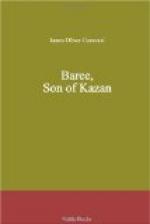This rabbit was the climax in the first chapter of Baree’s education. It was as if Gray Wolf and Kazan had planned it all out, so that he might receive his first instruction in the art of killing. When Kazan had dropped it, Baree approached the big hare cautiously. The back of Wapoos, the rabbit, was broken. His round eyes were glazed, and he had ceased to feel pain. But to Baree, as he dug his tiny teeth into the heavy fur under Wapoos’s throat, the hare was very much alive. The teeth did not go through into the flesh. With puppyish fierceness Baree hung on. He thought that he was killing. He could feel the dying convulsions of Wapoos. He could hear the last gasping breaths leaving the warm body, and he snarled and tugged until finally he fell back with a mouthful of fur. When he returned to the attack, Wapoos was quite dead, and Baree continued to bite and snarl until Gray Wolf came with her sharp fangs and tore the rabbit to pieces. After that followed the feast.
So Baree came to understand that to eat meant to kill, and as other days and nights passed, there grew in him swiftly the hunger for flesh. In this he was the true wolf. From Kazan he had taken other and stronger inheritances of the dog. He was magnificently black, which in later days gave him the name of Kusketa Mohekun—the black wolf. On his breast was a white star. His right ear was tipped with white. His tail, at six weeks, was bushy and hung low. It was a wolf’s tail. His ears were Gray Wolf’s ears—sharp, short, pointed, always alert. His foreshoulders gave promise of being splendidly like Kazan’s, and when he stood up he was like the trace dog, except that he always stood sidewise to the point or object he was watching. This, again, was the wolf, for a dog faces the direction in which he is looking intently.
One brilliant night, when Baree was two months old, and when the sky was filled with stars and a June moon so bright that it seemed scarcely higher than the tall spruce tops, Baree settled back on his haunches and howled. It was a first effort. But there was no mistake in the note of it. It was the wolf howl. But a moment later when Baree slunk up to Kazan, as if deeply ashamed of his effort, he was wagging his tail in an unmistakably apologetic manner. And this again was the dog. If Tusoo, the dead Indian trapper, could have seen him then, he would have judged him by that wagging of his tail. It revealed the fact that deep in his heart—and in his soul, if we can concede that he had one—Baree was a dog.
In another way Tusoo would have found judgment of him. At two months the wolf whelp has forgotten how to play. He is a slinking part of the wilderness, already at work preying on creatures smaller and more helpless than himself. Baree still played. In his excursions away from the windfall he had never gone farther than the creek, a hundred yards from where his mother lay. He had helped to tear many dead and dying rabbits into pieces. He believed, if he thought upon the matter at all, that he was exceedingly fierce and courageous. But it was his ninth week before he felt his spurs and fought his terrible battle with the young owl in the edge of the thick forest.




